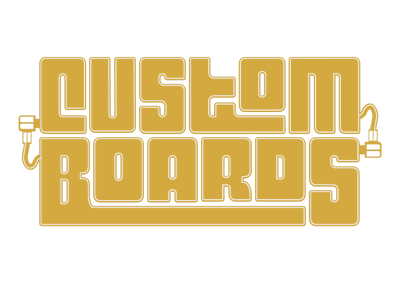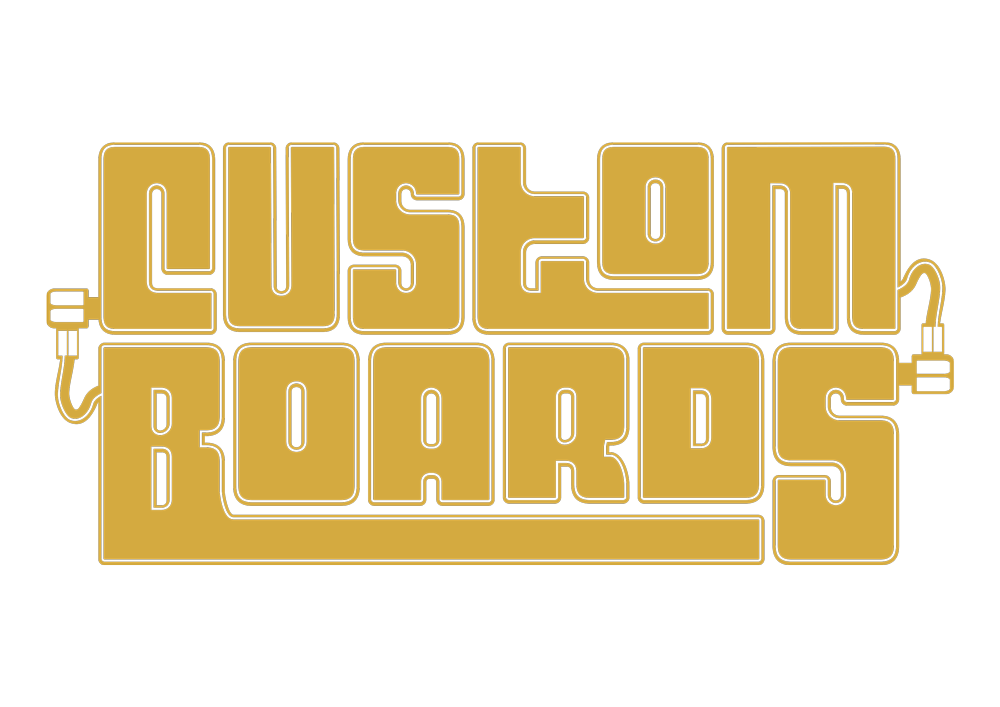A guide to power supply cables
The DC outputs on the power supply units (PSUs) made by Voodoo Lab and Strymon use the de facto standard of 2.1 mm outputs.

Cioks uses RCA outputs, which means their power supplies aren’t compatible with the DC cables used by other manufacturers. One advantage of RCA outputs and plugs is that they’re slightly more reliable mechanically, compared to a 2.1 mm socket, but in practice the difference is actually negligible.
We always prefer to use angled DC plugs on our Custom Boards pedalboards, when possible. The big exception are wah-wahs – due to their much thicker housing, straight plugs are generally the better choice for a safe connection.
Regardless of which cables are used, we strongly advise you to secure them using our Custom Boards Safety Clips to prevent accidental disconnection.
Connector types on pedals
2.1 mm plugs
Ninety-five percent of all pedals use a 2.1 mm DC input at 9 volts, with the centre contact carrying the negative and the outer contact carrying the positive part of the current. This is often called the “Boss-standard”. These types of cables are available in all kinds of lengths, both with angled and straight plugs. Usually a 2.1 mm plug is black.

With a Cioks there’s always one end that connects to the power supply (RCA) while the other (2.1 mm) goes to the pedal.

2.1 mm plugs with reverse polarity
Some effects need to feed their transistors the other way around. Those pedals sport the same 2.1 mm input, but now the centre is meant to carry the positive side. In many cases such pedals will be a traditional fuzz, like a germanium Fuzz Face or an Octafuzz.

Check out the video below and see how to measure a DC cable’s voltage and polarity.
Voodoo Lab marks reverse-polarity plugs in white.

Cioks uses red color to identify the 2.5 mm connector.

A 2.5 mm plug and socket look very similar, but are larger than their 2.1 mm counterparts. The 2.5 mm plug is used for Line 6 and Eventide effects, which amounts to approximately two percent of all pedals. This type of cable is almost always “reverse-polarity” with a positive centre and a negative outer contact. Many AC-powered pedals also use a 2.5 mm input.
Voodoo Lab’s 2.5 mm plug is red.

Cioks has chosen green as their colour to identify 2.5 mm reserse polarity plug.

One exception to the rule of 2.5 mm plug being always reverse polarity is the the Line 6 HD Bean, POD HD 500X, HX and HX Stomp effects. Cioks offers a cable for powering these pedals, which is labeled as yellow.

Voodoo Lab cable for HX Stomp is blue.

3.5 mm phone plugs
Some vintage pedals require an 3.5 mm phone plug (aka the mini-plug). These inputs all have the same polarity, meaning that all DC cables with 3.5 mm phone plugs can be used with all pedals carrying this connector. Cioks has their own cable, that can be found from here.

No DC input?
Effects that are designed to run on batteries only can still be run off of a PSU thanks to their press-fit battery clip. A battery snap always has the same polarity, which means you can use any DC cable equipped with battery clip in any effect.

On very cramped pedalboards using the battery clip can give you valuable extra space, compared to a 2.1 mm plug. The press-fit battery clip is also a very reliable connector, especially if you improve its grip carefully with a pair of pliers.
You should finish by wrapping the joined clips with some insulating tape or even a safety clip to prevent them from touching any of the electronics inside the effect.
Depending on the pedal’s collectability and the type of housing, you could use a small file to make a small channel in the casing to prevent the power cable from being pinched between the casing and the base plate.
*****
If you have purchased all the parts and components but get a feeling that you might not be up to the task after all, we can make your pedalboard for you, using the components you have bought from us. Don’t worry, we won’t let anything go to waste.



